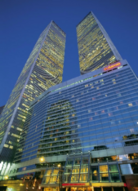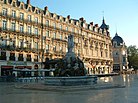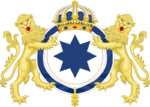Monitava
Monitava | |
|---|---|
City | |
Clockwise from top: Monitava skyline; Imperial Center; Old City Center; Monitava Bay Front; Monitava Cathedral | |
| Founded by Vaszare I | 1832 |
| Government | |
| • Mayor | Rouna Nourdal |
| Population (2016) | |
| • City | 3,857,991 |
| • Metro | 11,338,542 |
| Demonym | Monitavan |
| Time zone | UTC +1 |
| Area code | (+64) 21 |
Monitava is the most populous city in the Kingdom of Kathia and the Province of Ivadia. The city has a population of 3.8 million, with a total of 7.3 million in the surrounding metropolis, representing about half of the population of the entire province. Located in the Monitava Bay, it was considered a fortified area but lacked development due to its proximity to Achysia, however in 1832 Vaszare I established a naval base here, and the city subsequently grew around it. By 1910, it had grown to the 3rd largest city with over 500,000 residents, and by the start of WW2 was the second largest city. The expanded megacity accounts for nearly 11 million people, making it one of the largest in Aurora.
However, the city was completely destroyed during the fierce fighting in Battle of Monitava, and further destroyed by Allied bombing and Second Battle of Monitava in 1944-45. The city was rebuilt in its modern grid form after the war, and the fresh start for the city saw it become the new administrative center for the fledging Auroran Community, for which it is now considered the de facto capital. By 1970, Monitava overtook Ravonne as the most populous city.
Today, Monitava is a renowned financial center, and is one of the major financial centers in Aurora and the world, and also hosts many museums and memorials. The city still hosts the major naval base for which it was built, and is also home to the Royal Kathic Naval Academy. Monitava is also home to the highest concentration of skyscrapers in Aurora, as well as many of the tallest skyscrapers on the continent.
It is also a very diverse city, with large immigrant neighborhoods that established themselves again in the 1950s. Immigrants make up nearly a quarter of the city's population as of the last census in 2011, and continues to attract many new immigrants as the city continues to grow.
Etymology
Monitava is named after Heyszal Monitava, a rebel who was executed during the later stages of the Wars of Religion by Daeron's forces.
History
Prior to 1832, the area had been home to a small naval base for nearly 200 years, but various wars had prevented the Kingdom and Empire from establishing a large naval presence due to its close proximity to long-time enemy, Achysia. However, the Kingdom of Kathia had established relatively peaceful relations with its neighbors after its defeat in the Republican Wars, and to increase economic activity in what was considered at the time a backwater area, established a large naval base in the protected bay. The initial base was complete by 1835, however expansion projects continued for nearly 100 years as the city expanded.
The first major population boom came as the naval base expanded, and the city went from 25,000 residents in 1831 to 100,000 by 1861. The flat plain allowed the city to sprawl, and avoid being as dense as the many older cities such as Corava and Vydau. However, almost all of the original buildings built in this period did not survive World War II.
The First World War saw a slowdown in population and economic activity, as people feared moving to a city so close to Achysia and front line of the war. The naval base, however, served as an extremely important tool for the Kathic military, as it could quickly supply troops and ships from there. As such, the base is widely considered a large factor in forcing the war to drag on. This would, however, mean that it became a prime target for the rapidly advancing Achysian forces in the Second World War. The Battle of Monitava lasted 3 months, and allowed Kathia some time to build up its forces before being surrounded, and the city was forced to surrender.
Under Achysian occupation, most of the city was left in ruin, however the naval base was rebuilt enough for the Achysian Navy to use it. Many outer communities survived total destruction, and as a result homes and apartment blocks became crowded, and many people moved to other cities. The population declined from 1 million at the start of the war to nearly 800,000 by 1946. In 1945, the city was recaptured by Kathic forces and rebuilding plans began.
The Rebuilding of Monitava took nearly 30 years to complete, and some scholars believe it wasn't officially over until 1980. Many do consider the completion of the Imperial Center in 1974 to be the real end, though. However, due to no law existing to protect the now-destroyed historic areas of the city, the original street plan and original neighborhoods were leveled and replaced with a more grid-like system that now forms the downtown area. The original city center would come to be home to a majority of the city's skyscrapers. In 1949, some measures were taken to restore the Aszourdal neighborhood, which is were the original town stood, and is today one of the few remaining areas that is preserved in pre-war conditions.
The post-war use of automobiles also meant the city was a testing ground for the new Autoroute system, and many people moved to new suburbs as Kathia transitioned from densely populated cities to white-collar single family homes. Whilst the city is known for its large scale single-family home tracts, it is still more common to see apartment blocks similar to other Kathic and Auroran cities.
Economy
Since the 1980s, Monitava has become the largest economic engine in Kathia, and one of largest in the world. The city is also home to the largest port in Kathia, the Port of Monitava, which as been the nation's leading port since the 1850s. Several international corporations have their headquarters in Monitava, such as Air Kathia, Bank of the East, Evas, and a multitude of other companies. The Royal Government is a major employer in the Bay Area, along with the Auroran Community. Both of whom maintain large offices in the city. The Royal Government continues to be a large tenet in the Imperial Center. A large number of foreign companies have offices in the city, especially in the downtown area of the city. The city is also home to a growing technology companies, particularly in the Kourvas district outside of downtown. The city has a GDP of around Ↄ500 billion, about 75% of Caliszava's total GDP.
Monitava is home to some of the most expensive real estate in Aurora. The total real estate in the city is worth about Ↄ980, and real estate as a whole is a large part of the economy. The most expensive real estate transaction in Kathia occured in 2009 when the Imperial Center was purchased by Feveral Land for Ↄ4.1 billion.
The city has become a large tourist destination, being the second biggest tourist city after Ravonne. Major attractions include the Old Docks (now repurposed as an upscale shipping district), the Imperial Center, Monitava Zoo, Monitava Aquarium, Royal Center of the Preforming Arts, Monitava Botanical Gardens, Caliszava Air & Space Museum, and the Royal Vaszare Park in downtown Monitava.
Status as the Capital of the Auroran Community
Demographics
Transportation
Air
Monitava-Vourane International Airport serves as the main airport, and is also the second busiest in Kathia and one of the busiest in the world. It handles 59.4 million passengers in 2018. Monitava Bay Airport serves as a secondary airport, and many low-cost carriers utilize it rather than Monitava-Vourane.
Rail
The city was founded during the early days of rail transportation, and as such the rail network in the city is considered very efficient due to the clean slate rail network that was constructed during the mid-19th and 20th centuries. The city, along with Corava, was the first line to be opened for the Kathic Inert-City High Speed Rail System in 1981.
Monitava is served by mainly by Monitava Imperial Station, which was originally built in 1898, but destroyed during World War Two. It was rebuilt by 1949 and that station was subsequently torn down and replaced by the current building in 2012 after the Monitava Imperial Station fire in 2008. Monitava Imperial remains one of the busiest passenger stations in Aurora.
Ship
Shipping served as the backbone of the city's economy for more than a century, and still today remains the most important port in Kathia and one of the world's busiest.
Public Transport
Public transportation is headed by the Monitava Bay Area Regional Transit.The city has constructed an extensive Metro network, which is largely underground. While the first line opened in 1936, a second line was expected to be finished in 1943, however construction was halted in 1939 due to the Second World War. The second line was completed in 1949, with 6 more lines completed since then. The Monitava-Bay Area Metro has been the busiest in Kathia since 1983. The city is also served by buses, and also has an extensive regional rail network, the Bay Area Regional Rail.






